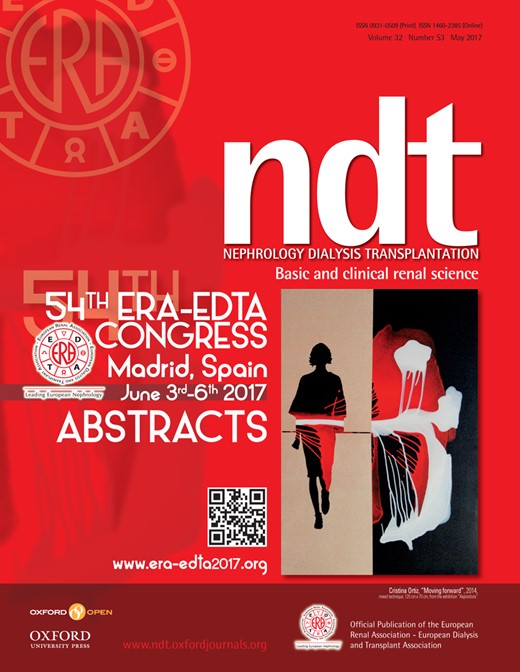-
PDF
- Split View
-
Views
-
Cite
Cite
Carla Viegas, Lúcia Santos, Anjos Macedo, Rute Morais, Ana Silva, Pedro Neves, António Matos, Cees Vermeer, Dina Simes, MO055
CIRCULATING CALCIPROTEIN PARTICLES AND EXTRACELLULAR VESICLES AS NOVEL PLAYERS IN CHRONIC KIDNEY DISEASE VASCULAR CALCIFICATION. A ROLE FOR GLA-RICH PROTEIN, Nephrology Dialysis Transplantation, Volume 32, Issue suppl_3, May 2017, Pages iii67–iii68, https://doi.org/10.1093/ndt/gfx123.MO055Close - Share Icon Share
INTRODUCTION AND AIMS: Vascular calcification (VC) is a complex process depending on the presence of systemic and local calcification inhibitors, highly prevalent in chronic kidney disease (CKD). The identification of a fetuin-A-containing mineral complex, or calciprotein particle (CPP), highlighted a possible mechanism to prevent systemic mineralization. Nevertheless, the composition and pathophysiological significance of circulating CPPs associated to CKD remains elusive. Extracellular vesicles (EVs) are novel players in pathological VC, although their potential use as VC biomarkers is still unknown. GRP is a novel inhibitor of cardiovascular calcification, shown to be involved in the mineralization-competence of VSMCs-derived EVs. Our aim is to investigate the association of GRP with CPP formation and circulating EVs, and study the pathogenic effect of CKD CPPs and EVs in vascular calcification.
METHODS: Biological CPPs and EVs were isolated from healthy (CTR) and CKD patients by differential centrifugation and ultracentrifugation, and characterized in terms of protein and mineral content using ultrastructural, analytical, molecular and immuno-based techniques. To evaluate the effect of CPPs and EVs in vascular calcification, different variations of CKD5 and CTR sera combined with isolated CPPs and EVs, were used to culture primary vascular smooth muscle cells (VSMCs) in calcifying conditions. Mineralization was evaluated through calcium quantification and qPCR for gene expression analysis.
RESULTS: Our results showed that CPPs derived from CKD stage 5 (CKD5) serum contain lower levels of the mineralization inhibitors fetuin-A and GRP, and increased maturation of the mineral crystals. CKD5 EVs were loaded with decreased levels of fetuin-A and GRP while increased annexin VI. Increased mineralization of VSMCs cultured in CKD5 serum was inhibited when CPPs and EVs were removed, and supplementation of CTR depleted CPPs and EVs sera with isolated CKD5 CPPs and EVs induced mineralization. Uremic CPPs and EVs alter VCMCs calcification by modulating cell differentiation and inflammation. Incubation of CKD5 CPPs with cGRP abolished calcification promoted by CKD5 CPPs.
CONCLUSIONS: CPPs and EVs are important players in the mechanisms of widespread calcification occurring in CKD, with a preponderant role for GRP. Decreased levels of mineralization inhibitors, such as GRP and fetuin-A leading to the formation of a more crystalline mineral in CPP, and to a decreased mineralization inhibitory capacity of EVs, are most likely major factors responsible for the CPPs and EVs toxicity. GRP is shown to be a crucial component in calcification inhibitory mechanisms, and we propose a biomarker utility for this protein to assess an individual’s calcific risk.





Comments